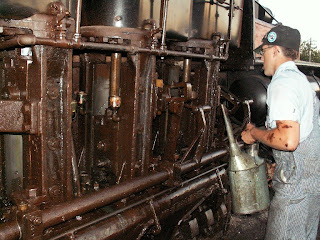This year, the 9 needed additional attention to get it to the point shown in the next three pictures. (Note: the next three pictures are courtesy of photographer John M. John's services are available for commercial work; he can be reached at this email address.)



After the initial July, 2010, challenges of getting the boiler to pass inspection (see the shop blog entries for the July 4th weekend), it was decided to replace every stud holding the steam dome's lid in place. Years of removal and replacement of the lid had caused the studs to splay outwards, making the July lid removal extremely difficult.
Shop volunteers Jesse V. and Griffin W. wrestle with the removal of the remaining studs.

The steam dome has all of its studs removed and the threads repaired.

This view is looking straight down into the 9's boiler. The large hole is the connection to the horizontal dry pipe which leads to the front of the boiler. It should be noted that the reason to remove the steam dome lid was to access the connection between the throttle body and the dry pipe. The connection has the propensity to leak, causing stray steam to enter the locomotive's steam cylinders regardless of the throttle bar position.

Looking towards the rear of the locomotive. The steam dome glamor cover is on the left, balanced carefully on top of the steam cylinders. The steam dome lid is in front of the glamor cover.

The new studs awaiting installation.

Upon close inspection, it was noted that the steam dome lid had bent from all of the removal/replacement cycles.
In case you've lost track of what has been discovered amiss with the 9:
1. In July, the yearly pressure test failed due to leaking superheater connections.
2. The superheaters should not have had water in them, with the likely culprit being a leaking throttle body to dry pipe connection.
3. Fixing the throttle body to dry pipe connection required removing the steam dome lid, but the splayed studs prevented the lid's removal
4. The studs didn't want to come out, but eventually were removed and replaced.
5. Now, the steam dome lid needed to be repaired.
The staff moved the lid from its perch on top of the locomotive to ground level for repairs.



Most of the studs have been replaced.

While the steam dome lid was being prepared for repair, the throttle body/dry pipe connection was corrected and replaced.

With the steam dome lid at ground level for a close inspection, it was decided that it was bent too far and a new lid needed fabrication.
Griffin W. welded the old lid to a new piece of 1" steel plate to be used as a template for drilling the new lid's holes.



After Griffin had drilled all of the holes, the staff discovered that the lid would not fit on our rotary mill. Cutting the corners off the 2' square plate solved that problem.

After placing the new lid on the rotary mill, the excess metal was machined off making a perfectly round lid.



The throttle body and the steam dome lid were installed, the boiler was topped up and the was fire lit for the pressure test.

No superheaters leaked, but a "dummy" flue along the top of the smoke box flue sheet leaked. A) remove superheaters; B) remove the leaking flue; C) install a new flue; D) replace the superheaters.





The fire was lit again after everything was back in or on the boiler. The pressure was increased to 150% of normal operating pressure and...it passed! After the inspection, the boiler was drained to an appropriate water level, a "real" fire lit, and the boiler was brought to operating pressure with steam instead of a high pressure pump.

Part of the fireman's job is lubricating the various moving parts of the locomotive. The next bunch of pictures feature Student Fireman John G. readying the 9 for use.





Opening a water injector line valve.

Starting the air compressor.

A clean stack during fire-up.


After several days use, the water connection from the tender to the locomotive failed, spewing water all over the south station platform. Staff replaces the pipes to ready for 9 for use (again!).


Engineer Dustin B. backs the 9 up to its train while fireman Griffin W. maintains steady pressure.



On a specially groomed track location, cab crew (l to r) Elliot H, Griffin W., Dustin B., Jesse V., and John G. pose for the camera.

-steam.airman
Photos courtesy steam.airman, Jennifer B., and John G.
Photos courtesy steam.airman, Jennifer B., and John G.





